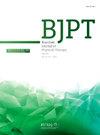Unraveling the role of fear and avoidance behavior in chronic musculoskeletal pain: from theory to physical therapy clinical practice
IF 3.2
3区 医学
Q1 ORTHOPEDICS
引用次数: 0
Abstract
Background
Protective behaviors in the context of pain fostered by fear are helpful in acute traumatic pain to enable a person to protect their body from further injury and promote healing in the short term. However, protective behavior that is ongoing in the absence of tissue damage may contribute to the persistence of disability in people with musculoskeletal pain. Current evidence highlights the importance of addressing pain-related fear, fear of movement-related pain, and avoidance behavior in the management of people with chronic musculoskeletal pain. But, physical therapists find it challenging to make sense of and implement the evidence in their clinical practice. This issue partly stems from the pervasiveness of the biomedical model, which fails to address important psychological factors such as fear of movement-related pain and avoidance behavior and their role in chronic musculoskeletal pain. Despite a wider acceptance of the biopsychosocial model of care, physical therapists lack confidence and guidance on how to implement this model into practice.
Objective
The aims of this masterclass are twofold: (1) to describe how the concepts/theory of fear learning can be applied in physical therapy practice for people with chronic musculoskeletal pain, (2) to illustrate the implementation of these concepts in clinical practice using an example of the management of a person with a chronic musculoskeletal pain condition.
Discussion
We discuss how clinicians may identify and target fear of movement-related pain and avoidance behavior in clinical practice, with examples of how to understand and manage individuals with chronic musculoskeletal pain using an associative learning and behavioral framework.
揭示恐惧和回避行为在慢性肌肉骨骼疼痛中的作用:从理论到物理治疗临床实践
背景:由于恐惧而产生的疼痛保护行为有助于缓解急性创伤性疼痛,使人们能够保护自己的身体免受进一步的伤害,并在短期内促进愈合。然而,在没有组织损伤的情况下进行的保护行为可能会导致肌肉骨骼疼痛患者持续残疾。目前的证据强调了解决疼痛相关恐惧、对运动相关疼痛的恐惧以及在慢性肌肉骨骼疼痛患者管理中的回避行为的重要性。但是,物理治疗师发现在他们的临床实践中理解和实施证据是具有挑战性的。这一问题部分源于生物医学模型的普遍性,它未能解决重要的心理因素,如对运动相关疼痛的恐惧和回避行为及其在慢性肌肉骨骼疼痛中的作用。尽管生物心理社会治疗模式已被广泛接受,但物理治疗师对如何将这种模式付诸实践缺乏信心和指导。本大师班的目的有两个:(1)描述如何将恐惧学习的概念/理论应用于慢性肌肉骨骼疼痛患者的物理治疗实践中;(2)通过一个慢性肌肉骨骼疼痛患者的治疗实例来说明这些概念在临床实践中的实施。我们讨论临床医生如何在临床实践中识别和针对运动相关疼痛的恐惧和回避行为,并举例说明如何使用联想学习和行为框架来理解和管理慢性肌肉骨骼疼痛患者。
本文章由计算机程序翻译,如有差异,请以英文原文为准。
求助全文
约1分钟内获得全文
求助全文
来源期刊
CiteScore
6.10
自引率
8.80%
发文量
53
审稿时长
74 days
期刊介绍:
The Brazilian Journal of Physical Therapy (BJPT) is the official publication of the Brazilian Society of Physical Therapy Research and Graduate Studies (ABRAPG-Ft). It publishes original research articles on topics related to the areas of physical therapy and rehabilitation sciences, including clinical, basic or applied studies on the assessment, prevention, and treatment of movement disorders.

 求助内容:
求助内容: 应助结果提醒方式:
应助结果提醒方式:


